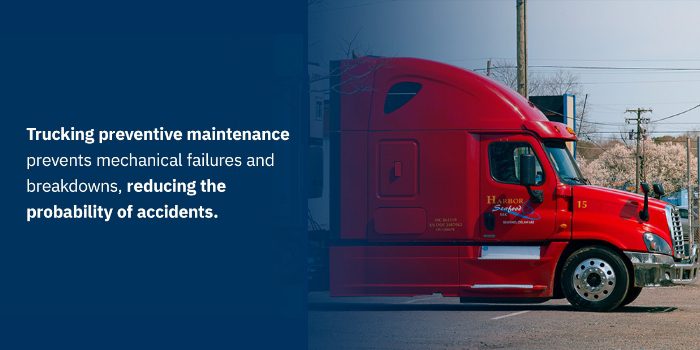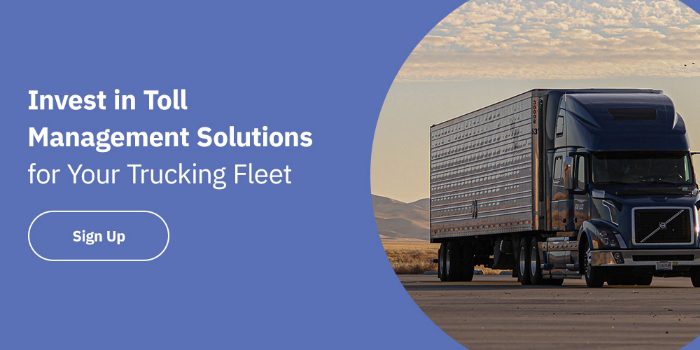
The Importance of Preventive Fleet Maintenance
The average truck driver drives about 100,000 miles a year — that’s over 86,500 more annual miles than the average motorist. With so many hours spent on the road, it’s natural for semitrucks to experience wear and tear. Without the proper upkeep, these minor issues can worsen, leading to a higher risk of breakdowns and accidents.
You can keep your trucking fleet operating in peak condition with preventive fleet maintenance. When you follow a routine preventive maintenance checklist, you can expect optimal safety, performance and longevity for your vehicles.
What Is Preventive Fleet Maintenance?
Trucking preventive maintenance refers to regular inspections, upkeep and repairs that contribute to a vehicle’s long-term performance, safety and reliability. By performing scheduled services to keep trucks in optimal condition, fleet maintenance minimizes the risk of unexpected issues that could lead to costly breakdowns.
Regular maintenance programs typically include
- Inspections: Preventive maintenance inspections assess a vehicle’s condition by identifying signs of damage and determining what services can correct them.
- Cleaning: This step may involve cleaning certain components or a complete truck wash.
- Testing: Regular testing evaluates a vehicle’s operation and functionality by testing its systems and components.
- Repairs: Technicians make minor repairs to fix issues discovered through inspections and testing.
- Part replacements: Through this step, the technician replaces any worn truck parts with new components.
- Lubrication: This step involves adding fluids and lubricant to trucks — like oil changes, component greasing or anti-freeze.
Preventive maintenance is proactive and predictive, meaning it intends to prevent breakdowns rather than fix problems after a breakdown happens, which is known as reactive maintenance. Preventive maintenance is much more cost-effective than reactive maintenance, reducing the chance of major mechanical issues and failures that reactive maintenance fixes.
Benefits of Trucking Preventive Maintenance
Investing in trucking fleet maintenance comes with many operational, financial and safety advantages for your trucking fleet. When you use a fleet maintenance checklist for regular vehicle upkeep, you can leverage these benefits for your trucking company.
Avoid Breakdowns
The average fleet truck breaks down every 10,000 miles. Some of the most common causes of semitruck breakdowns include brake, tire, engine and battery problems — all of which you can prevent with routine maintenance.
Performing preventive maintenance reduces the frequency of breakdowns significantly. Top-performing fleets with well-developed maintenance programs can travel over seven times the distance of the average truck, with breakdowns occurring every 75,528 miles. With fewer breakdowns comes minimal downtime from travel interruptions and repairs.
Reduce Repair Costs
Preventive fleet maintenance corrects minor issues with small-scale repairs before they become major failures. This upkeep helps prevent serious breakdowns, helping your trucking company avoid the high expenses needed to fix them. That means your company can experience significant cost savings when you do regular fleet maintenance.
Improve Fuel Efficiency
Truck preventive maintenance addresses many systems and parts that contribute heavily to fuel consumption, like oil, tire pressure, suspension and spark plugs. Regularly maintaining these crucial components ensures they operate at peak performance, ultimately optimizing your vehicles’ fuel efficiency. As a result, your company can improve fleet performance and minimize fuel costs while reducing carbon dioxide emissions.
Increase Driver Safety
According to the Federal Motor Carrier Safety Administration, brake problems account for 29% of large truck crashes, while tire problems make up 6% of these accidents. Together, these malfunctions cause 49,000 truck accidents annually. Trucking preventive maintenance prevents these mechanical failures and breakdowns, reducing the probability of accidents. That means your truck drivers and other motorists are safer on the road when your fleet trucks are properly maintained.

Trucking Fleet Maintenance Best Practices
When creating and implementing a preventive maintenance program for your fleet, take certain steps to ensure that your plan is successful. Keep these fleet maintenance best practices in mind when developing a program for your trucking fleet.
1. Create a Preventive Fleet Maintenance Checklist
Your maintenance program’s most vital resource is its preventive maintenance checklist. This list itemizes all activities that should be performed during scheduled maintenance. These tasks will vary by truck type. It’s important that your maintenance checklist accounts for all of your vehicles’ components to ensure all parts are fully maintained.
Your fleet maintenance checklist should include these steps:
- Change engine oil and filters.
- Check the transmission fluid and change or fill it as needed.
- Assess the cooling and fuel systems.
- Evaluate braking components and replace rotors and pads as needed.
- Inspect electrical system components.
- Inspect the engine and transmission mounts.
- Check the steering and suspension.
- Evaluate belts, hoses, CV joints and the drive shaft and replace them when necessary.
- Perform general tune-ups.
- Inspect and rotate tires, rims and wheels.
- Check for and repair fluid leaks.
- Check undercarriage and frame conditions.
- Inspect the exhaust system.
- Test windshield wipers and check wiper fluid.
- Assess the truck body, mirrors and glass.
- Test the horn, seat belts and auxiliary systems.
- Test interior and exterior lights.
2. Determine Maintenance Intervals
Now that you have a maintenance checklist, decide how often you should perform these tasks. Consider the following factors when determining your upkeep frequency:
- Vehicle type
- Mileage
- Engine hours
- Operating conditions
- Fuel usage
- Operating hours
You shouldn’t perform preventive maintenance any more or less than your established maintenance intervals.
3. Establish a Record-Keeping Method
It’s a good rule of thumb to keep detailed records of your trucks’ maintenance histories. This documentation helps your company keep track of all maintenance activities that were performed on each of your vehicles and when.
Consistent record-keeping ensures that vehicle maintenance is never forgotten, repeated or performed at random intervals. Maintenance records also protect your company from liabilities should your drivers get in an accident caused by vehicle malfunctions — these records prove the failure wasn’t due to a lack of proper maintenance on your end.
4. Encourage Driver Reporting
Your drivers know your trucks best, making them your first line of defense against vehicle malfunctions. That’s why your preventive maintenance program should encourage workers to report any vehicle problems they see. When drivers communicate these issues, your maintenance team can proactively repair them before they slip through the cracks and cause a major breakdown.
Make sure your drivers know to monitor and report safety issues like soft brakes, vehicle idling, misfires, brake screeching, worn windshield wipers and body damage.
5. Keep Spare Parts Stocked
Much of your maintenance tasks rely on spare parts. That’s why it’s important to keep your replacement parts fully stocked at all times. Not having the required components on hand when you need them can push back your maintenance schedule, leading to significant delays impacting your entire fleet. Take inventory of your repair parts frequently so you can order new ones before you need them.
Learn How to Create Your Preventative Maintenance Program
Invest in Toll Management Solutions for Your Trucking Fleet
With so many vital maintenance tasks to perform, it’s easy for toll management to fall by the wayside. Take control of your toll payments without lifting a finger with innovative software from Bestpass. Our comprehensive payment platform is designed to bridge the gap between you and the tolling authorities with hassle-free toll management. With our tolling solutions, you can save more time and money for your company.
Sign up to get started with our toll management software today!


